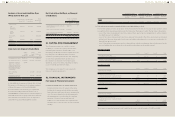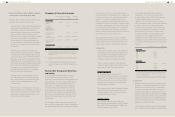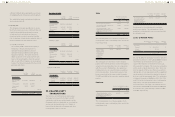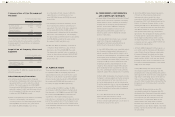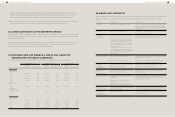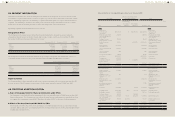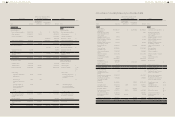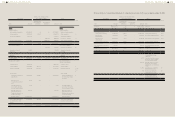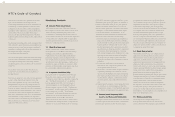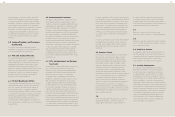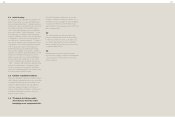HTC 2013 Annual Report Download - page 158
Download and view the complete annual report
Please find page 158 of the 2013 HTC annual report below. You can navigate through the pages in the report by either clicking on the pages listed below, or by using the keyword search tool below to find specific information within the annual report.
FINANCIAL INFORMATION FINANCIAL INFORMATION
312 313
account is not clearly defined. However, under
IFRSs, it defines "provisions" as obligations that
are probable (i.e., more likely than not) and
the amount could be reasonably estimated.
Thus, as of January 1 and December 31, 2012,
the reclassification adjustment resulted in
decreases of NT$15,133,275 thousand and
NT$8,881,514 thousand, respectively, in "other
current liabilities" and increases by the same
amounts in "provisions - current."
f) Accumulated compensated absences are not
addressed in existing ROC GAAP; thus, the
Company has not recognized the expected
cost of employee benefits in the form of
accumulated compensated absences at the
end of reporting periods. However, under
IFRSs, when the employees render services
that increase their entitlement to future
compensated absences, an entity should
recognize the expected cost of employee
benefits at the end of reporting periods. Thus,
as of January 1, 2012, the IFRS adjustment
resulted in an increase in "accrued expenses"
by NT$99,321 thousand and a decrease by the
same amount in "accumulated earnings." In
addition, the evaluation adjustment made on
December 31, 2012 resulted in (a) a decrease
in "accumulated earnings" by NT$93,451
thousand due to an increase of "accrued
expenses"; (b) decreases in "cost of revenues"
by NT$5,299 thousand and "selling and
marketing expenses" by NT$4,843 thousand
and (c) increases in "general and administrative
expenses" by NT$557 thousand and "research
and developing expenses" by NT$3,715
thousand.
g) Under ROC GAAP, deferred charges are
classified under other assets. Transition to IFRSs,
deferred charges are classified under "property,
plant and equipment", "other intangible assets"
and "other assets - other" according to the
nature. Thus, as of January 1 and, December
31, 2012, the Company reclassified NT$410,217
thousand and NT$571,485 thousand,
respectively, of "deferred charges" to "property,
plant and equipment"; and reclassified
NT$207,033 thousand and NT$162,765
thousand, respectively, of "deferred charges"
to "other intangible assets" and reclassified
NT$146,266 thousand and NT$162,914
thousand, respectively, of "deferred charges"
to "other assets - other".
h) The Company purchased fixed assets and
made prepayments, pursuant to the "Rules
Governing the Preparation of Financial
Statements by Securities Issuers." Such
prepayments are presented as "properties".
Transition to IFRSs, the prepayments are
classified under "other assets - other". Thus,
as of January 1 and December 31, 2012, the
Company reclassified NT$207,062 thousand
and NT$232,011 thousand, respectively, of
"property, plant and equipment" to "other
assets - other".
i) Under ROC GAAP, if an investee issues new
shares and an investor does not purchase new
shares proportionately, capital surplus and the
long-term equity investment accounts should
be adjusted for the change in the investor's
holding percentage and interest in the investee's
net assets. By contrast, under IFRSs, a reduction
of investor's ownership interest that results in
loss of significant influence on or control over
an investee would be treated as a deemed
disposal, with the related gain or loss recognized
in profit or loss. An entity may elect not to
adjust the difference retrospectively, and the
Company elected to use the exemption from
retrospective application. The IFRS adjustment
resulted in a decrease of capital surplus - long-
term equity investments of NT$18,037 thousand
and a corresponding increase of accumulated
earnings by related rules.
j) The Company elected to reset the accumulated
balances of exchange differences resulting
from translating foreign operation to zero at
the date of transition to IFRSs, and the reversal
has been used to adjust accumulated earnings
as of January 1, 2012. The gain or loss on any
subsequent disposals of any foreign
operations should exclude accumulated
balances of exchange differences resulting
from translating foreign operation that
arose before the date of transition to IFRSs.
Therefore, the IFRS adjustment resulted
in a decrease in accumulated balances
of exchange differences resulting from
translating foreign operation and an increase
in accumulated earnings by NT$32,134
thousand each.
6) Material adjustment to consolidated statement
of cash flows
Under ROC GAAP, using the indirect method, the
interests and dividends received and interests
paid were usually classified as operating cash
flows, and dividends paid were usually classified
as financial cash flows and supplemental cash
flows information is provided for interests paid.
However, under IFRS 7, cash flows from interest
and dividends received and paid shall each be
disclosed separately. Each shall be classified in a
consistent manner from period to period either
as operating, investing or financing activities.
Thus, for the year ended December 31, 2012, the
cash flows of interests and dividends received
in the amount of NT$589,899 thousand and
NT$22,441 thousand were disclosed separately.
As of January 1 and December 31, 2012, time
deposits with original maturities more than three
months amounted to NT$25,474,750 thousand
and NT$2,911,924 thousand, respectively, and not
to be classified as "cash and cash equivalents"
in accordance with IFRSs since they are held for
investment purpose. For more details of this
adjustment, please refer to Note 40 section b. 5)
a).
Except for the above, the Company's
consolidated statement of cash flows in
accordance with IFRSs and ROC GAAP had no
other significant differences.



